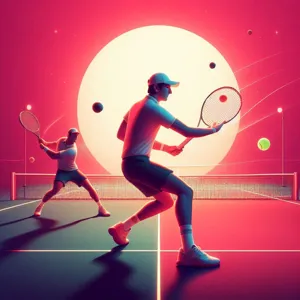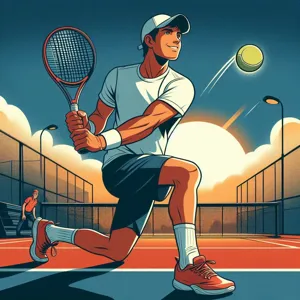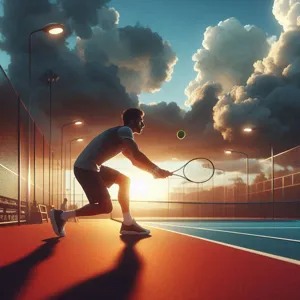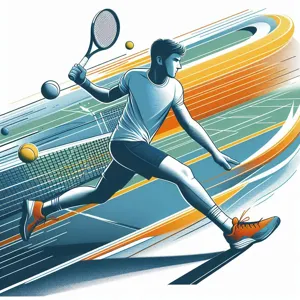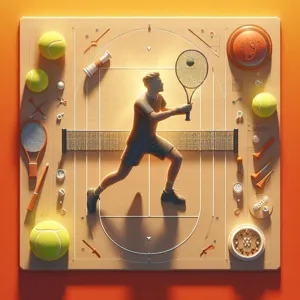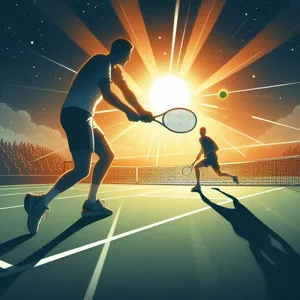Tennis, a game of precision and strategy, often puts players face-to-face with formidable opponents who seem to possess an edge in skill, strength, or experience.
While the thrill of competition can be exhilarating, facing a stronger opponent can also be daunting, creating a sense of pressure that may hinder your performance. However, every match presents an opportunity to learn and grow, and with the right mindset and strategies, you can level the playing field. In this blog post, we will explore effective techniques and mental strategies that can help you not only survive but thrive against tougher competitors. From honing your tactical awareness to leveraging psychological resilience, these tips will empower you to take control of the match, elevate your game, and turn challenges into triumphs on the court. Join us as we delve into the art of mastering the challenge, transforming the way you approach each match and building the confidence to elevate your tennis skills.
1. Understanding Your Opponent: Analyzing Strengths and Weaknesses
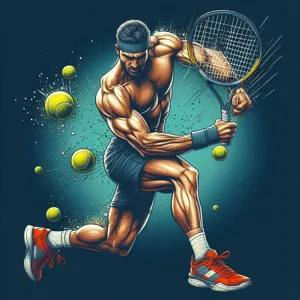
When stepping onto the court against a stronger opponent, knowledge is your greatest ally. Understanding your opponent’s game—analyzing their strengths and weaknesses—can provide you with the insights needed to craft a strategic approach to the match. Begin by observing their playing style. Are they aggressive baseline hitters, or do they prefer to come to the net? Do they have a powerful serve that sets the tone for each point, or are their returns more focused on precision than power?
Take note of their shot selection during the match. Strong players often have well-rounded skills, but they may still lean toward certain tactics. Perhaps they struggle with low balls or have difficulty responding to a backhand slice. By identifying these nuances, you can exploit their vulnerabilities.
Additionally, consider their mental game. Are they prone to frustration when points don’t go their way? Do they maintain composure under pressure, or do they falter in crucial moments? Understanding their psychological resilience can inform your tactics—targeting them during moments of vulnerability can shift the momentum in your favor.
Gathering this information doesn’t just happen in a single match; it’s an ongoing process. Watch previous matches, if available, and look for patterns in their play. This type of detailed analysis not only prepares you physically for the match but also cultivates a mental strategy that can make a significant difference in your performance. By entering the match with a clear understanding of your opponent, you equip yourself with the tools needed to level the playing field and potentially turn the tide in your favor.
2. Mental Preparation: Building Confidence and Resilience
When facing a stronger opponent on the tennis court, mental preparation can be your secret weapon. The ability to build confidence and resilience is essential not only for your performance but also for your overall mindset during the match. Strong players are not just physically skilled; they often possess a psychological edge that comes from their self-assurance and mental toughness.
To cultivate this confidence, start by visualizing your success. Spend time imagining yourself executing perfect serves, returning powerful shots, and ultimately winning crucial points. Visualization is a powerful technique that can help transform your mental landscape, allowing you to approach the match with a mindset geared towards victory.
Additionally, focus on setting realistic goals for your match. Instead of fixating on winning, shift your attention to specific, achievable objectives, such as maintaining a high first-serve percentage or successfully executing a particular strategy. This approach not only eases the pressure of competing against a stronger opponent but also provides you with clear targets to strive for, boosting your confidence as you make progress.
Resilience is equally crucial when the match becomes challenging. Embrace the inevitable ups and downs of the game. Acknowledge that mistakes are part of the process and use them as learning opportunities rather than sources of frustration. Developing a mantra—a simple phrase or affirmation that you can repeat to yourself during tough moments—can help reinforce your mental strength. Phrases like “Stay focused” or “One point at a time” can keep you grounded and remind you to maintain your composure in the face of adversity.
Finally, practice mindfulness techniques, such as deep breathing or meditation, to help manage anxiety and maintain your focus during the match. A calm mind allows you to think clearly and make better decisions on the court, regardless of your opponent’s skill level. Building confidence and resilience through mental preparation is not just about winning; it’s about fostering a strong, competitive spirit that can carry you through any match, no matter how tough it may be. Embrace these strategies, and you’ll find yourself stepping onto the court with a renewed sense of belief in your abilities.
3. Developing a Game Plan: Tailoring Your Strategy

When facing a stronger opponent, developing a game plan is not just beneficial; it’s essential. Tailoring your strategy to leverage your strengths while exploiting your opponent’s weaknesses can turn the tide of a match. Start by analyzing your own game—identify your best shots, preferred court positions, and mental resilience. Are you a powerful server, or do you excel at constructing points through consistency and placement? Understanding your own strengths allows you to build a strategy that plays to them.
Next, research your opponent. Observe their playing style, shot preferences, and behaviors during matches. Do they struggle with high balls or low slices? Are they prone to rushing the net, or do they prefer to rally from the baseline? If you have access to past matches, take notes on patterns that seem to arise consistently.
Once you’ve gathered this information, create a tactical plan for the match. For example, if your opponent is known for their aggressive forehand, consider targeting their backhand to force them out of their comfort zone. Incorporate variety into your shots—mix up spins, speeds, and angles to disrupt their rhythm. Additionally, consider your pacing; an aggressive approach may catch them off guard, but a more patient, defensive style could exploit any hasty decisions they make.
Visualize your plan before stepping on the court. Picture yourself executing the strategy with confidence and adaptability. Remember, tennis is a dynamic sport, and while having a game plan is crucial, being flexible and ready to adjust your strategy in response to how the match unfolds is equally important. By entering the match with a tailored approach, you not only increase your chances of success, but you also boost your own confidence, making you a formidable competitor, even against stronger opponents.
4. Leveraging Your Strengths: Playing to Your Advantages
When faced with a stronger tennis opponent, one of the most effective strategies is to leverage your unique strengths. Every player has specific skills and qualities that set them apart on the court, and recognizing these advantages can turn the tide of a match in your favor.
Begin by assessing your strengths honestly. Are you known for your powerful serve that can catch opponents off guard? Or perhaps your agility allows you to cover the court like a gazelle, returning shots that seem impossible to reach? Maybe your strategic mind gives you an edge in anticipating your opponent’s moves. Whatever your strengths may be, the key is to maximize them during your match.
For instance, if you possess a strong baseline game, focus on constructing points that favor long rallies. By engaging your opponent in extended exchanges, you can exploit their weaknesses, tire them out, and force them into making errors. If quick reflexes are your forte, utilize them to dominate at the net, intercepting volleys and playing a more aggressive style that can surprise a more powerful opponent.
Additionally, consider how to blend your strengths with smart tactics. If your opponent struggles against high-bouncing shots, incorporate topspin into your arsenal. If they have difficulty with slice, mix in low balls that force awkward returns. This approach not only utilizes your strengths but also disrupts your opponent’s rhythm, making it harder for them to play to their own advantages.
Ultimately, playing to your strengths is about confidence and conviction. Trust in your abilities, stick to your game plan, and don’t be afraid to take calculated risks. By doing so, you can shift the pressure back onto your opponent and create opportunities to gain the upper hand, proving that even in the face of a stronger adversary, you have the potential to claim victory.
5. Focus on Fitness: Enhancing Stamina and Endurance

When facing a stronger opponent on the tennis court, one of the most effective strategies you can adopt is to prioritize your fitness, specifically by enhancing your stamina and endurance. Tennis is a physically demanding sport that requires not just skill but also the ability to maintain peak performance throughout the match. By focusing on your fitness, you can level the playing field and give yourself a fighting chance against a more powerful adversary.
Start by incorporating a well-rounded fitness regimen into your training routine. This should include cardiovascular exercises like running, cycling, or swimming to boost your overall endurance. Aim for at least 30 minutes of aerobic activity several times a week. High-intensity interval training (HIIT) can also be extremely beneficial, as it mimics the stop-and-start nature of tennis, helping your body adapt to the demands of rapid movement and quick recovery.
Strength training is equally important for building the muscle necessary to withstand prolonged rallies and powerful shots. Focus on core strength, as a strong core contributes significantly to your balance and stability on the court. Exercises such as planks, squats, and lunges will not only enhance your physical power but also improve your agility, allowing you to move swiftly in response to your opponent’s shots.
In addition to physical training, don’t underestimate the mental aspect of endurance. Maintaining focus during long matches can be exhausting, so practice mindfulness techniques or visualization exercises to enhance your mental stamina. This will help you stay calm and composed, even when the match gets challenging.
Lastly, prioritize recovery as part of your fitness strategy. Adequate rest, hydration, and nutrition are crucial for allowing your body to bounce back after intense training sessions and matches. A well-rested player is more resilient and better prepared to face tough opponents head-on.
By focusing on improving your fitness, you can enhance your stamina and endurance, allowing you to outlast stronger opponents and seize opportunities when they arise. In the game of tennis, stamina can often be the difference between victory and defeat, so make it a cornerstone of your training strategy.
6. Sharpening Your Skills: Key Techniques to Practice
When facing a stronger opponent, sharpening your skills becomes not just an advantage but a necessity. The right techniques can transform your game and level the playing field. Here are some key areas to focus on during your practice sessions, ensuring you’re ready to tackle even the toughest competitors.
**1. Footwork Fundamentals:**
Quick and agile footwork is essential in tennis, allowing you to position yourself optimally for each shot. Dedicate time to drills that enhance your lateral movement and balance. Simple exercises like ladder drills or cone sprints can improve your agility, helping you cover the court more efficiently. The more nimble you are, the better equipped you’ll be to respond to your opponent’s powerful shots.
**2. Serve Precision:**
Your serve can be one of your greatest weapons, especially when competing against a stronger player. Focus on developing a consistent and accurate serve. Practice different types of serves—flat, spin, and slice—to keep your opponent guessing. A strong serve can not only earn you easy points but also give you the upper hand in controlling the pace of the game.
**3. Shot Variety:**
Relying on a single style of play can make you predictable. Incorporate a variety of shots into your practice, including topspin groundstrokes, drop shots, and volleys. This versatility will allow you to adapt during matches, catching your opponent off guard and exploiting their weaknesses.
**4. Mental Fortitude:**
Tennis is as much a mental game as it is physical. Practice visualization techniques to enhance your focus and confidence. Imagining yourself executing perfect shots and winning points can help condition your mind for success when it matters most. Additionally, developing strategies for managing pressure during tight moments will keep you composed, allowing you to perform at your best.
**5. Match Simulation:**
Finally, nothing beats the experience of playing matches. Organize practice matches against players of varying skill levels to simulate competitive scenarios. This exposure will help you apply the techniques you’ve been working on, allowing you to refine your strategy and discover areas for improvement in a real-game context.
By honing these key techniques, you’ll not only increase your skill level but also approach each match against a stronger opponent with confidence. Consistent practice and a commitment to improvement will help you rise to the challenge and elevate your game to new heights.
7. Effective Shot Selection: Choosing the Right Shots at the Right Time

In the high-stakes world of tennis, where the margins between victory and defeat can be razor-thin, effective shot selection becomes a crucial strategy, especially when facing a stronger opponent. The essence of shot selection lies not just in hitting the ball hard or aiming for the corners of the court, but in making calculated decisions that leverage your unique strengths while exploiting your opponent’s weaknesses.
Start by assessing your opponent’s style of play. Are they aggressive and prone to charging the net, or do they prefer to rally from the baseline? Understanding their tendencies allows you to craft a tactical game plan. For instance, if your opponent excels at volleying, consider employing deep, heavy topspin shots that push them back and keep them off-balance. Conversely, if they struggle with low balls, incorporating slice shots can disrupt their rhythm and create opportunities for you to take control of the rally.
Timing is everything in shot selection. Knowing when to be aggressive and when to play it safe is key. In crucial moments, such as break points or tiebreaks, a well-placed shot can make all the difference. Don’t hesitate to mix in unexpected shots like drop shots or lobs to catch your opponent off guard. These can be particularly effective if you’ve established a pattern that your opponent expects you to follow.
Moreover, consider your own physical condition and comfort level with different types of shots. Choosing shots that align with your strengths—whether it’s a powerful forehand, a reliable backhand, or a deft touch at the net—can significantly enhance your confidence on the court. Always keep in mind that shot selection is not only about individual strikes but also about the broader strategy of the match. Each shot should contribute to a larger narrative, setting up your next move and keeping your opponent guessing.
By mastering the art of effective shot selection, you not only tilt the odds in your favor but also transform the match into a mental duel. Remember, in tennis, every point is a new opportunity to outsmart your opponent—so choose wisely, play strategically, and watch as your confidence grows alongside your game.
8. Mind Games: Using Psychological Tactics to Gain an Edge
In the high-stakes arena of tennis, where physical prowess meets mental acuity, psychological tactics can be the key differentiator between victory and defeat. Competing against a stronger opponent often requires you to step beyond pure athleticism and tap into the intricate world of mind games. These strategies are not just about outplaying your opponent on the court but also about outsmarting them in the mental battle.
One of the most effective psychological tactics is to maintain a steady, calm demeanor, even when the pressure mounts. By projecting confidence, you can create doubt in your opponent’s mind. They may start to second-guess their shots or hesitate before making aggressive plays, allowing you to capitalize on their uncertainty. Conversely, if your opponent senses anxiety or frustration, they may begin to feel they have the upper hand, which can shift the momentum of the match.
Another powerful technique is to vary your playing style and strategies unexpectedly. If you typically play aggressively, consider adopting a more defensive approach at times. This unpredictability can frustrate a stronger opponent who thrives on rhythm and consistency. Mix up your serves, employ drop shots, or change your positioning on the court to keep them guessing. This not only disrupts their game but can also lead to unforced errors as they struggle to adapt.
Additionally, leverage the power of body language. Use subtle movements and gestures to project confidence—standing tall, making eye contact, and displaying an unwavering focus can send a clear message that you are in control. Conversely, pay attention to your opponent’s body language; signs of frustration, fatigue, or indecision can be cues to intensify your pressure.
Finally, consider the mental aspect of pre-match preparation. Engage in visualization techniques, where you imagine yourself succeeding against your opponent, picturing every point, shot, and strategy in vivid detail. This mental rehearsal not only boosts your confidence but also prepares you to face challenges with a positive mindset.
By mastering these psychological tactics, you can transform the challenge of facing a stronger opponent into an opportunity for strategic advantage. In tennis, as in life, the mind often holds the most powerful keys to success.
9. Adapting to Different Playing Styles: Flexibility on the Court
Adapting to different playing styles is essential for any tennis player looking to excel, especially when faced with a stronger opponent. The ability to remain flexible on the court can be the deciding factor between victory and defeat. Each player brings a unique set of skills, strategies, and tendencies, and understanding how to adjust your game in response can turn the tide of a match.
Begin by observing your opponent’s strengths and weaknesses during the warm-up or the early games. Are they aggressive at the net, favoring a serve-and-volley style, or do they prefer to stay at the baseline, relying on powerful groundstrokes? Pay close attention to their footwork, shot selection, and court positioning. This initial analysis will provide crucial insights into how you can alter your own game to exploit any vulnerabilities.
Moreover, embrace the idea of versatility in your own playing style. If your opponent thrives on pace and power, consider incorporating more spin into your shots to disrupt their rhythm. Utilizing a variety of shot placements can also keep them guessing, forcing them to adapt to your strategy. For instance, mixing up your serves by alternating between flat, slice, and kick serves can create opportunities for you to gain the upper hand.
Mental flexibility is just as important as physical adaptability. Stay composed and focused, even if your opponent is playing at a higher level. Embrace the challenge and view it as an opportunity to develop your skills. By maintaining a positive mindset and being willing to adjust your tactics, you can find ways to counteract their game plan effectively.
In conclusion, flexibility on the court isn’t merely about physical adjustments; it encompasses a strategic mindset that enables you to respond to various playing styles. By honing your observation skills, embracing a versatile approach, and cultivating mental resilience, you can level the playing field and turn even the toughest matches into opportunities for growth and success.
10. Staying Positive: Maintaining a Winning Mindset
When facing a stronger tennis opponent, maintaining a positive mindset can be your most potent weapon. Tennis is as much a mental game as it is a physical one, and your attitude on the court can significantly influence your performance. The importance of positivity cannot be overstated; it helps you stay focused, resilient, and ready to tackle challenges head-on.
Start by cultivating a strong self-talk routine. Replace negative thoughts with empowering affirmations that reinforce your abilities. Instead of thinking, “I can’t win this match,” shift to, “I can learn and grow from this experience.” This simple change in perspective can transform your approach and performance. Visualize yourself playing confidently and executing your shots effectively. Imagine overcoming obstacles and celebrating small victories throughout the match, whether it’s a well-placed serve or a hard-fought rally.
Moreover, embrace the idea of enjoying the game, regardless of the outcome. Shift your focus from the score to the experience itself. Each match is an opportunity to learn, improve, and refine your skills. By concentrating on your gameplay and enjoying the challenge, you’ll find that pressure diminishes, and your performance can soar.
Surround yourself with positivity, whether that means training with supportive teammates, listening to motivating music before a match, or even engaging in mindfulness techniques like deep breathing or meditation. These practices can help calm your nerves and keep your mindset sharp.
Lastly, remember that every champion has faced defeat. Embrace the lessons that come from every match, and use them as stepping stones toward improvement. With a winning mindset, you’ll not only compete against stronger opponents, but you’ll also develop the resilience and confidence that will serve you well in every aspect of your tennis journey.
11. Learning from Each Match: Embracing Growth and Improvement
In the world of tennis, every match presents an opportunity for growth, regardless of the outcome. Competing against a stronger opponent can often feel intimidating, but it’s crucial to approach each encounter with a mindset geared toward learning and improvement. Rather than viewing these matches solely as a measure of success or failure, shift your perspective to see them as invaluable lessons in your tennis journey.
After each match, take time to reflect on your performance. Analyze the strategies your opponent employed and identify areas where they excelled. Were they consistently serving aces? Did they anticipate your shots better? By dissecting these aspects, you can gain insight into what makes a player successful at a higher level. Keeping a journal of your matches can help you track patterns, pinpoint weaknesses, and celebrate victories—no matter how small.
Moreover, consider seeking feedback from coaches or more experienced players who witnessed your match. They can provide objective observations that may shed light on aspects you might have overlooked. Perhaps your footwork needs improvement, or maybe your shot selection could be more strategic. Embrace constructive criticism as a vital part of your growth; it’s a stepping stone toward becoming a more skilled player.
Additionally, incorporate the lessons learned into your training regimen. If you noticed that your opponent excels in net play, dedicate practice time to enhancing your volleying skills. If their baseline game is strong, work on your consistency and shot placement. By targeting specific areas of improvement, you’ll not only become a more competitive player but also develop a deeper understanding of the game.
Ultimately, the key to mastering the challenge of facing stronger opponents lies in your willingness to embrace growth. Each match is a chapter in your tennis story, filled with opportunities for development. By approaching these experiences with an open mind and a commitment to improvement, you’ll find that even the toughest competitions can lead to remarkable progress on your journey to becoming a better player.
12. The Importance of Footwork: Positioning for Success
In the world of tennis, footwork is often the unsung hero of a player’s success. While powerful serves and skillful shots grab the headlines, it is the ability to move swiftly and efficiently around the court that can truly make or break your performance against a stronger opponent. Good footwork not only enables you to reach the ball in time but also positions you optimally to execute your shots with finesse and power.
Imagine stepping onto the court, your heart racing and adrenaline pumping as you face an opponent known for their aggressive play. The first step in leveling the playing field lies in mastering your footwork. Focus on your stance—keeping your knees slightly bent and your weight balanced on the balls of your feet allows for quick, responsive movements. Practice the essential footwork patterns: side shuffles, cross-steps, and quick pivots. These drills help cultivate muscle memory, ensuring you can react instinctively when the pressure is on.
Moreover, positioning is key. Anticipate where the ball is headed and move into the ideal spot before your opponent strikes. This proactive approach not only gives you a better chance to return the shot but also allows you to control the rally. Use small, quick steps to adjust your position, enabling you to maintain balance and readiness for whatever comes next.
Do not underestimate the power of court awareness, either. By keeping your eyes on your opponent’s body language and racket angle, you can predict their next move, allowing you to position yourself strategically. This heightened awareness, combined with agile footwork, can turn the tide of a match, enabling you to outmaneuver even the most formidable foes.
In conclusion, while you may enter the court as the underdog, impeccable footwork can be your secret weapon. By honing your agility and positioning, you’ll not only enhance your own game but instill doubt in your opponent, creating opportunities to seize control of the match. Remember, success in tennis is not just about hitting the ball harder; it’s about being in the right place at the right time.
13. Utilizing Court Awareness: Reading the Game as It Unfolds
When facing a stronger opponent on the tennis court, one of the most potent tools at your disposal is your ability to read the game as it unfolds. Court awareness transcends mere observation; it encompasses understanding your opponent’s tendencies, anticipating their next move, and positioning yourself strategically to counter their strengths.
Start by paying close attention to your opponent’s patterns. Does she favor her forehand on critical points? Does he struggle with backhand returns when under pressure? By identifying these patterns early on, you can adjust your tactics to exploit weaknesses. For instance, if your opponent consistently hits to your backhand, you can prepare for those shots and set up your responses accordingly, whether that means positioning yourself to intercept or anticipating their next strike.
Moreover, court awareness extends to your own positioning. Always be mindful of where you stand in relation to both the ball and your opponent. The more aware you are of the court dimensions and your opponent’s positioning, the better you can maneuver to cut off angles and create opportunities. If you notice your opponent is leaning toward one side, take that split second to shift your own weight and prepare for a counter-strike, effectively putting yourself one step ahead.
Lastly, embrace the fluidity of the game. Tennis is dynamic, with rallies that can change in an instant. Keep your head up, your eyes on the ball, and your mind engaged. This not only helps you read the game better but also allows you to adapt your strategy in real-time based on the unfolding match dynamics. By fostering a keen sense of court awareness, you’ll not only enhance your defensive capabilities but also create offensive opportunities, leveling the playing field against even the toughest opponents.
14. Preparing for Match Day: Routine and Rituals
Preparing for match day is as much about mental readiness as it is about physical prowess. Establishing a pre-match routine can significantly influence your performance and help you compete against even the strongest opponents. A well-crafted routine not only calms nerves but also primes your body and mind for the battle ahead.
Start the day with a nutritious breakfast that fuels your energy levels. Incorporate complex carbohydrates and proteins—think oatmeal with fruits and nuts or a smoothie packed with greens and protein powder. This will prepare your body for the demands of the match, ensuring you have sustained energy throughout.
Next, consider a consistent warm-up routine that you follow before every match. This should include dynamic stretches and tennis-specific drills that not only get your heart rate up but also help you find your rhythm. Spend some time on the court hitting balls to dial in your timing and touch, focusing on your serve and groundstrokes. A solid warm-up can enhance muscle memory, making your strokes feel more natural and instinctive during the match.
Mental preparation is equally crucial. Visualize yourself playing confidently and successfully against your opponent. Imagine each point, from the serve to the final shot, executing your strategies flawlessly. This mental rehearsal can foster a sense of control and positivity, reducing anxiety and boosting your confidence.
Incorporate rituals that ground you and bring focus. Whether it’s a specific breathing exercise, listening to a motivational playlist, or even a quick meditation session, these practices can help center your mind and focus your thoughts. Many elite players have their own unique rituals, and finding what resonates with you can provide a comforting routine that helps elevate your performance.
Finally, stay hydrated and allow yourself moments of rest. Whether you’re sitting quietly with your thoughts or engaging in light conversation with your coach or teammates, taking breaks can help manage pre-match jitters. By creating a structured and familiar routine for match day, you can foster a sense of calm and readiness that will be instrumental in competing against stronger opponents. With the right preparation, you can step onto the court feeling empowered, confident, and ready to unleash your best game.
15. Conclusion: Embracing the Challenge and Growing as a Player
In the world of tennis, facing a stronger opponent can be both daunting and exhilarating. It’s easy to feel overwhelmed by their skill and experience, but it’s essential to shift your perspective and embrace this challenge as an opportunity for growth. Competing against a higher-caliber player can be a catalyst for self-improvement, pushing you to sharpen your technique, enhance your mental resilience, and expand your strategic thinking on the court.
As you step onto the court, remember that every match is a learning experience. Analyze your opponent’s strengths and weaknesses, and use this insight to refine your own game plan. Every point played against a superior player offers invaluable lessons—whether it’s mastering your serve, improving your footwork, or becoming more adept at reading your opponent’s shots.
Additionally, approaching each match with a positive mindset is crucial. Understand that losing is not a reflection of your worth as a player; instead, it’s part of the journey. Embrace the discomfort of competition, as it fosters resilience and character. By facing and overcoming these challenges, you’ll not only improve your skills but also develop a deeper love for the game.
In conclusion, don’t shy away from the opportunity to compete against stronger opponents. Instead, welcome the challenge as a stepping stone toward becoming a better player. With each match, you expand your abilities, grow in confidence, and deepen your understanding of the sport. So, lace up your shoes, take a deep breath, and step onto the court with the mindset of a champion—ready to learn, adapt, and thrive. Embrace the challenge, and in doing so, you will undoubtedly grow as both a player and a competitor.
In conclusion, mastering the challenge of competing against a stronger tennis opponent requires a blend of mental fortitude, strategic thinking, and adaptability. By employing the strategies discussed—ranging from enhancing your physical conditioning to honing your mental game—you can turn the tide in your favor and elevate your performance on the court. Remember, every match is an opportunity for growth; embrace the challenge, learn from each experience, and use it to fuel your passion for the game. As you step onto the court for your next match, carry with you the knowledge and techniques that can transform adversity into triumph. With determination and the right mindset, you can hold your own against any opponent, making each encounter a stepping stone toward becoming a more formidable player. Happy playing, and may your next match be both challenging and rewarding!






